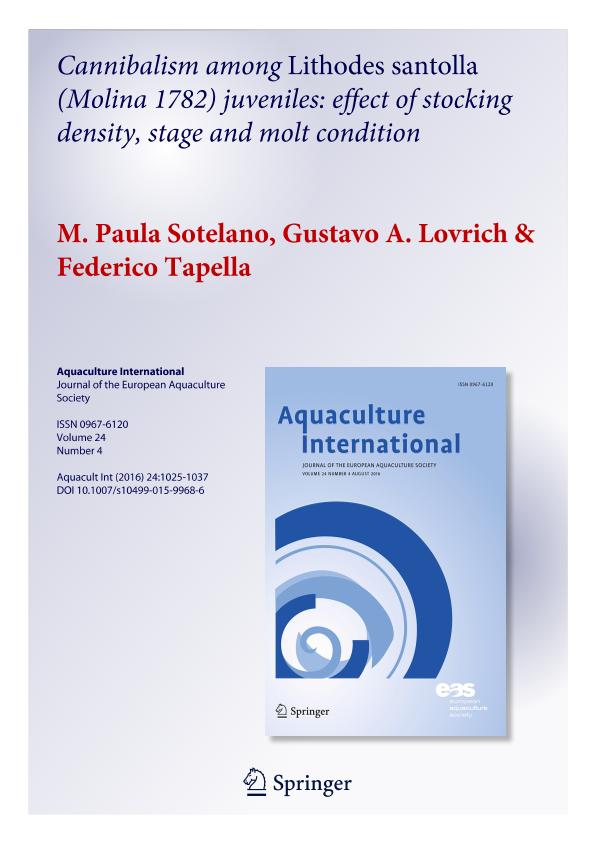Mostrar el registro sencillo del ítem
dc.contributor.author
Sotelano, María Paula

dc.contributor.author
Lovrich, Gustavo Alejandro

dc.contributor.author
Tapella, Federico

dc.date.available
2019-10-22T15:30:55Z
dc.date.issued
2016-08
dc.identifier.citation
Sotelano, María Paula; Lovrich, Gustavo Alejandro; Tapella, Federico; Cannibalism among Lithodes santolla (Molina 1782) juveniles: effect of stocking density, stage and molt condition; Springer; Aquaculture International; 24; 4; 8-2016; 1025-1037
dc.identifier.issn
0967-6120
dc.identifier.uri
http://hdl.handle.net/11336/86852
dc.description.abstract
Losses of king crabs (deaths) in massive rearing conditions are frequently attributed to cannibalism. As several factors could influence cannibalism intensity during culture, the aim of the present study was to determine the effect of molt condition, stage and density on cannibalism among Lithodes santolla juveniles. Comparisons between intermolt and molt conditions and between C1 and C2 stages during intermolt were performed at three densities (6, 12 and 18 individuals per flask; that is equivalent to 236, 472 and 708 individuals m−2). After 16 days of juvenile coexistence, cannibalism (injured + dead) was higher during molting (33.9 ± 4.5 %) than intermolt (21.7 ± 3.9 %), even though only 36 % of crabs had molted. Although cannibalism was similar in C1 and C2 stages, the proportion of dead animals was higher by a factor of three in C1 stage, probably due to the fact that animals reach the first juvenile stage with low energetic reserves, after the lecithotrophic larval development. Density was the main factor influencing cannibalism in our experiments. Higher densities promoted higher deaths, while agonistic interactions evidenced by injured crabs remained constant. Walking appendages were lost more often than chelipeds during first agonistic encounters. We recommend the use of intermediate densities (450 crabs m−2 at most), the early detection of exuviae and the sorting of crabs after molting, for L. santolla rearing.
dc.format
application/pdf
dc.language.iso
eng
dc.publisher
Springer

dc.rights
info:eu-repo/semantics/openAccess
dc.rights.uri
https://creativecommons.org/licenses/by-nc-sa/2.5/ar/
dc.subject
CANNIBALISM
dc.subject
CULTURE
dc.subject
JUVENILES
dc.subject
SOUTHERN KING CRAB
dc.subject
STOCK ENHANCEMENT
dc.subject.classification
Biología Marina, Limnología

dc.subject.classification
Ciencias Biológicas

dc.subject.classification
CIENCIAS NATURALES Y EXACTAS

dc.title
Cannibalism among Lithodes santolla (Molina 1782) juveniles: effect of stocking density, stage and molt condition
dc.type
info:eu-repo/semantics/article
dc.type
info:ar-repo/semantics/artículo
dc.type
info:eu-repo/semantics/publishedVersion
dc.date.updated
2019-03-11T14:09:21Z
dc.journal.volume
24
dc.journal.number
4
dc.journal.pagination
1025-1037
dc.journal.pais
Alemania

dc.journal.ciudad
Berlín
dc.description.fil
Fil: Sotelano, María Paula. Consejo Nacional de Investigaciones Científicas y Técnicas. Centro Austral de Investigaciones Científicas; Argentina
dc.description.fil
Fil: Lovrich, Gustavo Alejandro. Consejo Nacional de Investigaciones Científicas y Técnicas. Centro Austral de Investigaciones Científicas; Argentina
dc.description.fil
Fil: Tapella, Federico. Consejo Nacional de Investigaciones Científicas y Técnicas. Centro Austral de Investigaciones Científicas; Argentina
dc.journal.title
Aquaculture International

dc.relation.alternativeid
info:eu-repo/semantics/altIdentifier/url/https://link.springer.com/article/10.1007%2Fs10499-015-9968-6
dc.relation.alternativeid
info:eu-repo/semantics/altIdentifier/doi/http://dx.doi.org/10.1007/s10499-015-9968-6
Archivos asociados
